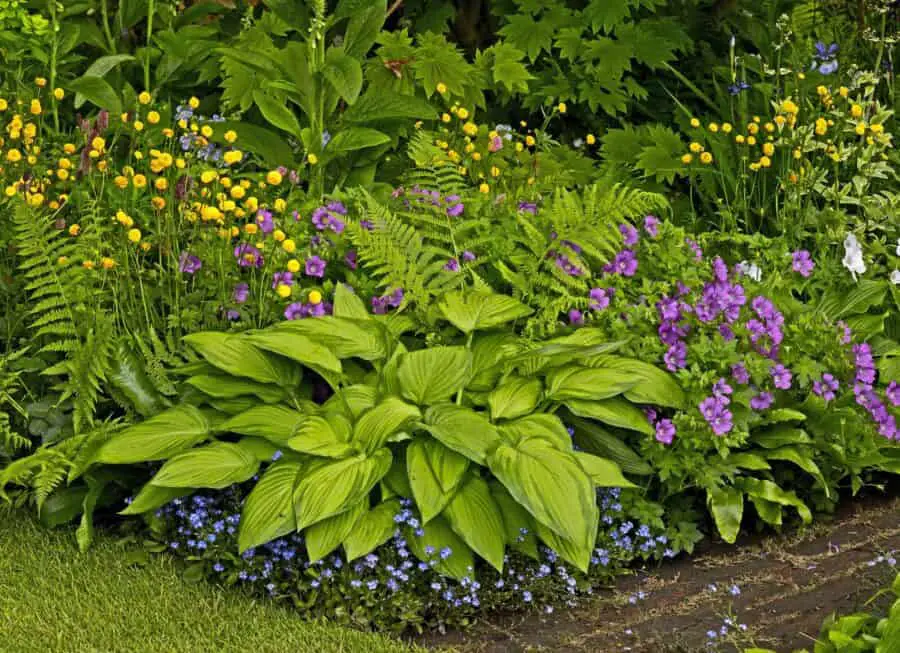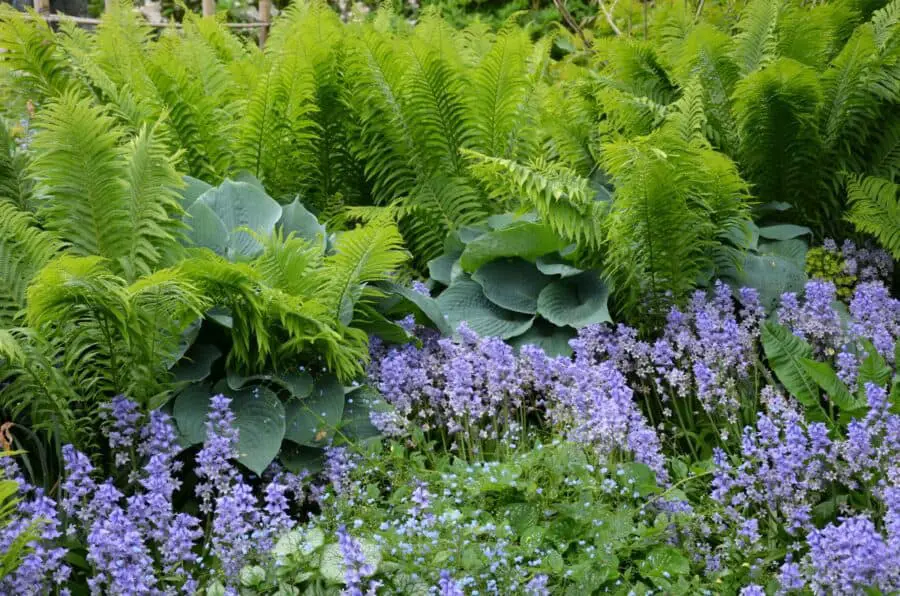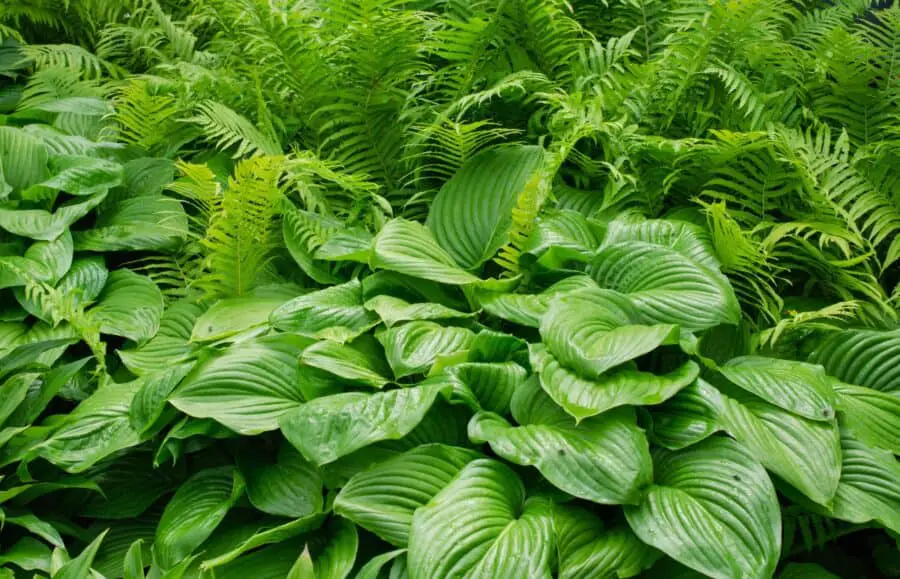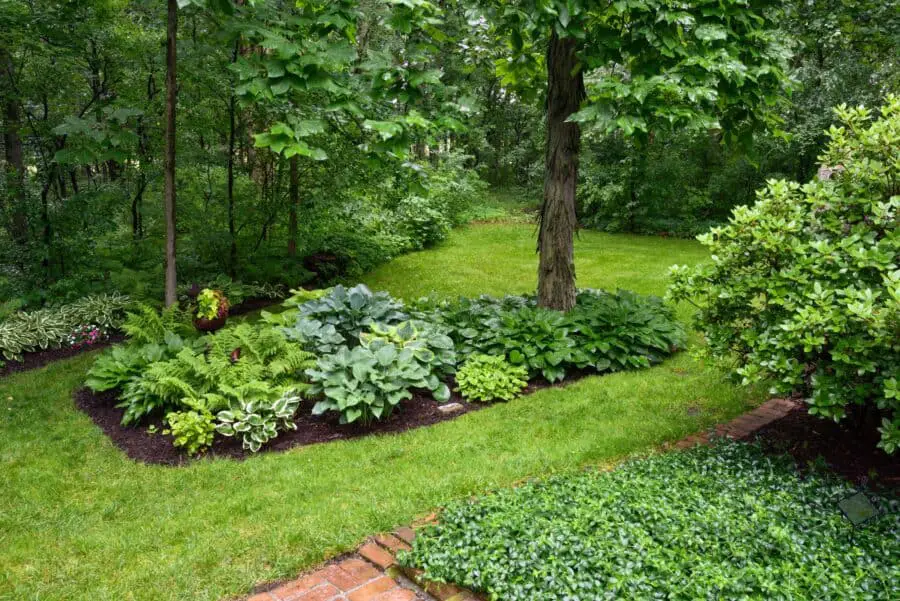Welcome, fellow garden enthusiasts! Imagine stepping into your lush, tranquil retreat, where the air is cool and fresh. A diverse array of ferns and hostas fill the landscape with rich, verdant textures.
This isn’t just a dream – a fern and hosta garden. This shaded oasis can transform any outdoor space into a serene sanctuary. Whether it’s the delicate, feathery fronds of the ferns or the bold, heart-shaped leaves of the hostas, there’s a captivating beauty in their diversity and resilience.
So, let’s delve into the enchanting world of fern and hosta gardens and explore how you can create, enhance, and, most importantly, enjoy your slice of shaded paradise.
A fern and hosta garden is an enchanting landscape primarily composed of ferns and hostas. These gardens have lush, textured foliage and can thrive in low-light conditions. Adding elements like paths, seating, water features, and garden art enhances gardens’ overall aesthetic and function.
Designing a Serene Fern and Hosta Garden to Transform Your Shady Spaces
Before we begin, we must look at your shady space and determine the shade you’re working with.
Is it dappled shade filtered through the branches of a tree, or is it deep shade created by a solid structure like a building or fence?
Remember that different ferns and hostas can handle varying degrees of shade. Knowing your site’s light conditions will help you choose the right plants for success.
Using Ferns and Hostas in Your Design
It is important to understand the critical characteristics of ferns and hostas to create an engaging and harmonious garden design. Ferns are known for their delicate, feathery fronds, which come in shades of green, bronze, and even silver.
They can range in size from small, compact varieties to larger, more dramatic types, making them versatile additions to your shady garden.
Conversely, Hostas boasts broad, textured leaves in various colors, including green, blue, gold, and even variegated combinations.
Some hostas also produce tall flower spikes in summer, adding an extra layer of interest. Like ferns, hostas are available in various sizes, from miniatures to large specimens, making them suitable for all garden spaces.
A well-designed fern and hosta garden should have a focal point to anchor the design and catch the eye. This could be a large hosta variety with striking foliage, a garden sculpture, or even a birdbath.
Once you’ve chosen a focal point, consider the surrounding plants and how their colors, textures, and forms will complement the centerpiece.
Also, think about the overall balance of the design, ensuring that your fern and hosta garden is visually appealing from all angles.

Layering Your Fern and Hosta Garden
Layering techniques are one of the most effective ways to create a dynamic and visually exciting garden. Start with the foundation layer, which will primarily consist of your hostas.
Position them according to their eventual size and growth habits, allowing adequate space between plants. This will ensure that each hosta has room to grow and can be appreciated for its unique attributes.
Next, add an accent layer using ferns, which will provide a delicate, feathery contrast to the bold leaves of hostas.
The fronds of ferns, like the Japanese painted fern or lady fern, can add a splash of color and a gentle swaying movement that gives your garden an almost magical quality.
When placing ferns, be mindful of their eventual height and spread so they don’t get lost behind your hostas.
Combining Colors, Textures, and Forms
A beautiful fern and hosta garden should feature a variety of colors, textures, and forms.
This can be achieved by selecting ferns and hostas with different leaf shapes, colors, and variegation patterns.
For example, a chartreuse-colored hosta can be paired with a deep green fern to create contrast. In contrast, a fern with delicate, lacy fronds can be placed alongside a hosta with heavily textured leaves.
Experimenting with these elements will result in a visually attractive and harmonious garden.
Mastering the Art of Plant Combinations for a Lush Fern and Hosta Garden

To take your fern and hosta garden to the next level, consider incorporating companion plants that thrive in the shade. These plants can enhance the overall appearance of your garden by adding splashes of color, interesting textures, and unique forms.
Incorporating Companion Plants
Some excellent flowering perennials and annuals include astilbe, bleeding heart, coral bells, begonia, caladium, and coleus. These plants provide vibrant blooms that can create striking contrasts against the backdrop of your ferns and hostas.
Astilbe
Astilbes are lovely plants that add delightful color and texture to your fern and hosta garden. These perennials thrive in moist, well-drained soil and prefer partial to full shade.
Astilbes produce feathery plumes in various shades, such as pink, red, and white, which contrast beautifully with the bold foliage of hostas and the delicate fronds of ferns.
Coral Bells (Heuchera)
Coral Bells, also known as Heuchera, provide stunning foliage and delicate flowers that complement the look of ferns and hostas.
They prefer part shade to full shade and offer a wide range of foliage colors, including deep purple, lime green, and silvery gray.
Plant Coral Bells near your hostas and ferns to create an exciting tapestry of foliage textures and colors.
Begonia
Begonias are versatile and attractive plants that blend well with ferns and hostas. They thrive in partial to full shade and prefer well-drained soil.
Begonias come in various forms, with colorful flowers and stunning foliage patterns that can brighten up the shaded areas in your garden. Plant begonias next to ferns and hostas for a visually appealing combination.
Bleeding Heart
Bleeding hearts (Dicentra spectabilis) add a touch of elegance and romance to your fern and hosta garden. Their arching stems with heart-shaped flowers create a graceful addition to shady spaces.
Bleeding hearts prefer partial to full shade and moist, well-drained soil. Consider placing them near hostas and ferns for a striking contrast of form and texture.
Caladium
Caladiums offer dramatic and colorful foliage that pairs excellently with the elegant greenery of ferns and hostas. These shade-loving plants prefer moist, well-drained soil and come in various colors, including red, white, and pink.
Plant caladiums among your ferns and hostas to introduce a pop of color and a bold foliage pattern to your garden.
Coleus
Coleus plants are celebrated for their vibrant and intricately patterned leaves, making them great companions for ferns and hostas. They thrive in partial to full shade and can adapt to various soil types.
Coleus plants come in a wide array of colors, such as magenta, yellow, and lime-green. Combine them with your hostas and ferns to create a vibrant and colorful garden display.
Shade-tolerant ornamental grasses, like Japanese forest grass or Carex, are also excellent additions. They add texture and movement to your garden, creating a soothing atmosphere.
Finally, ground covers like sweet woodruff or Vinca minor can help fill in gaps between your ferns and hostas. These plants create a lush carpet underfoot and help suppress weeds and maintain soil moisture.
With the suggested companion plants, your fern and hosta garden will be a beautiful tapestry of textures, colors, and forms.
These combinations will undoubtedly help you create a visually stunning garden space, especially in the challenging shaded areas where it’s harder for other plants to grow.

Balancing Color and Contrast
When creating plant combinations in your fern and hosta garden, it’s crucial to balance color and contrast. This can be achieved by thoughtfully selecting plants with complementary colors, textures, and forms.
For instance, try pairing a bold, blue-leaved hosta with a more delicate, silver-fronded fern. The contrasting colors and textures will create visual interest and depth, making your garden feel more dynamic and engaging.
Alternatively, combine a variegated hosta with a solid-colored fern or companion plant. This will not only create a pleasing contrast but also help to highlight the unique patterns and colors of your variegated hosta.
Experimenting with Plant Groupings
Consider experimenting with different plant groupings to create a stunning fern and hosta garden. You can evoke a sense of natural harmony and flow by arranging plants in clusters or drifts.
For example, try planting a large drift of a single fern species punctuated by bold hostas and colorful companion plants. This will create a visually striking display that draws the eye and invites exploration.
Alternatively, you could create a more intimate, woodland-inspired garden by intermingling ferns, hostas, and companion plants in small groupings.
This approach can create a sense of discovery as your eye moves from one plant combination to the next, uncovering new surprises.
Feel free to get creative and think outside the box when experimenting with plant groupings. The most important thing is to have fun and create a fern and hosta garden that reflects your unique style and personality.
Enhancing Your Fern and Hosta Garden
Explore how hardscaping, garden art, and lighting can transform your green oasis. These elements, thoughtfully incorporated, add depth, intrigue, and a magical ambiance to your fern and hosta garden, making it truly unforgettable.
Incorporating Hardscape Elements
While the lush foliage and captivating plant combinations in your fern and hosta garden will undoubtedly be the show’s stars, incorporating hardscaping elements can provide structure, functionality, and an added touch of beauty to your space.
A meandering pathway made from stepping stones or a winding gravel path will invite you and your visitors to explore the garden, experiencing its beauty up close.
The choice of materials and the shape of the pathway can significantly impact the overall aesthetic of your garden, so choose wisely to create the desired atmosphere.
Adding a bench or seating area nestled among the plants can create the perfect spot to relax, read a book, or enjoy your fern and hosta garden’s peaceful atmosphere.
Consider the seating’s material, color, and style to ensure it complements the surrounding plants and hardscape elements.
Introducing Garden Art and Sculpture
In addition to hardscaping, incorporating garden art or sculpture can provide a focal point and an extra layer of interest to your fern and hosta garden.
These elements can be both functional and decorative, offering an opportunity to showcase your personality and style.
For example, a garden statue can add a touch of elegance or whimsy. At the same time, a metal or glass sculpture can introduce a contemporary flair.
When selecting garden art, consider the size, material, and overall aesthetic to ensure it complements the surrounding plants and hardscaping.
Birdbaths and bird feeders are another way to add visual interest while also attracting wildlife to your fern and hosta garden.
The gentle sound of splashing water from a birdbath or the lively activity around a bird feeder can add an extra dimension of enjoyment to your garden experience.

Enhancing Your Garden with Lighting
Finally, consider incorporating lighting into your fern and hosta garden to extend its beauty into the evening hours. Soft, subtle lighting can highlight key plants or focal points and provide safety and functionality for pathways and seating areas.
Low-voltage LED lights, or solar-powered options are both energy-efficient choices that can be easily incorporated into your garden design.
Consider uplighting to showcase the unique textures of your ferns and hostas or downlighting to create a moonlit effect that casts intriguing shadows throughout your garden.
By combining thoughtful plant combinations, hardscaping elements, and carefully selected garden art and lighting, your fern and hosta garden will become a truly magical space for you to enjoy and share with others.
Expanding Your Fern and Hosta Garden: Exploring New Varieties and Themes
In this exciting section, we’ll dive into various fern and hosta varieties and innovative themes to rejuvenate and expand your garden. Let’s embark on this horticultural adventure to create an even more diverse, vibrant, and enticing fern and hosta garden.
Discovering New Fern and Hosta Varieties
As you continue to enjoy your fern and hosta garden, you may be interested in expanding your plant palette and exploring new varieties. With hundreds of fern and hosta cultivars available, there is always something new and exciting to try.
Consider experimenting with species that display unique frond shapes, colors, or textures for ferns. Some exciting options include the cinnamon, ostrich, or autumn fern, each of which brings distinctive charm to the garden.
In the world of hostas, there are endless possibilities for adding new colors, patterns, and leaf shapes to your collection.
Look for varieties with standout traits, such as the fragrant hosta ‘Guacamole’, the uniquely patterned ‘June’, or the dramatic ‘Empress Wu’, which boasts enormous leaves.

Designing Themed Gardens
Another way to expand your fern and hosta garden is by creating themed areas that showcase specific types of plants or evoke a particular atmosphere.
For example, you could create a blue hosta garden featuring different hostas with blue-toned leaves. This monochromatic approach can create a calming, soothing effect.
Alternatively, you might consider designing a woodland garden incorporating native ferns, hostas, and other shade-loving plants, creating a habitat for local wildlife and promoting biodiversity.
This approach provides visual interest and supports a healthier ecosystem in your backyard.
Patio and Container Gardens
Utilizing containers is a fantastic way to enhance your fern and hosta garden. Containers allow you to create versatile, eye-catching arrangements that can be easily rearranged or moved.
Here are some tips for designing your patio and container garden with ferns and hostas:
Choose a variety of container sizes and styles to add visual interest.
Mix textures and colors of ferns and hostas together in a single container for a stunning effect.
Place containers along walkways, entryways, or beside seating areas to highlight your plantings.
Elevate your containers on pot feet, bricks, or decorative stands to improve drainage and create visual depth.
Incorporating hostas and ferns in containers in your patio space adds a touch of elegance.
Integrating Water Elements
Adding water features to your fern and hosta garden can elevate its beauty and create a more serene atmosphere. Consider these ideas for incorporating water elements into your landscape:
Install a small pond or water garden surrounded by shade-loving ferns and hostas to create a peaceful focal point.
Place a bubbling fountain or bird bath among your fern and hosta plantings to attract birds and other wildlife.
Create a meandering stream or waterfall through your garden, lined with ferns and hostas, to add movement and soothing sounds.
Incorporate rain chains or decorative downspouts surrounded by ferns and hostas to capture runoff water and create visual interest.
Integrating water elements into your fern and hosta garden adds aesthetic appeal. It enhances the overall atmosphere and biodiversity of your outdoor space.
Remember to keep your water features clean and adequately maintained to enjoy them for years.

Embracing the Ever-Changing Nature of Your Garden
A fern and hosta garden is a living, evolving entity that will change and grow over time. As plants mature, you may need to reassess your garden’s layout or design, adding new plants or relocating existing ones to maintain balance and harmony.
Embrace this ever-changing nature of your garden and view it as an opportunity to experiment, learn, and grow as a gardener. With time, patience, and care, your fern and hosta garden will continue to provide you with joy, relaxation, and inspiration for years.